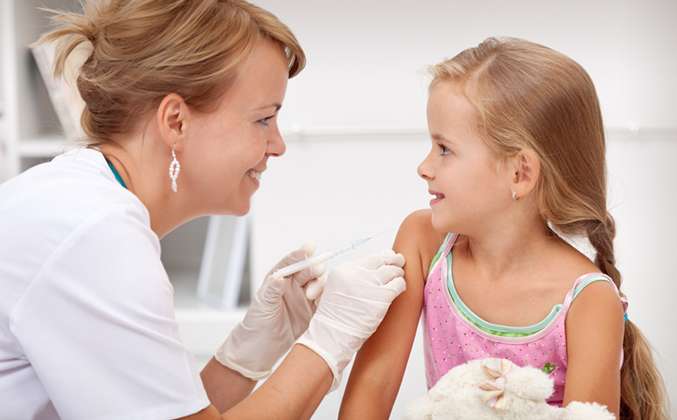Infectious disease physician dispels vaccine myths ahead of back-to-school physicals

Having updated vaccinations is an important step for children heading back to school.
In 2014, the Centers for Disease Control and Prevention (CDC) reported that vaccines have saved more the 732,000 lives during the past two decades. While studies have repeatedly shown vaccines are the best way to protect our communities from some of the deadliest illnesses, questions still arise.
Nadia Qureshi, MD, pediatric infectious disease physician at Loyola University Medical Center, and assistant professor of pediatrics at Loyola University Chicago Stritch School of Medicine, sheds light on some common myths about vaccines.
Myth #1: The MMR vaccine causes autism
The MMR vaccine protects people against measles, mumps and rubella. Children should get two doses of the MMR vaccine, starting with the first dose at 12 – 15 months and the second at 4 – 6 years. While the CDC says that two doses of the MMR vaccine are 97 percent effective at preventing measles, the myth of a connection to autism persists.
"This myth began in 1998 when an English surgeon published a study claiming the MMR vaccine was associated with autism and inflammatory bowel disease," Dr. Qureshi said. "No other studies have been able to replicate or validate these results. Later, it was discovered that he had fabricated and plagiarized clinical records and even was found to have patented a single vaccine for measles so the research finding would benefit him financially. His medical license was revoked and the paper was retracted."
Myth #2: Too many vaccines at one time is dangerous
"The immune system is constantly being challenged. From what infants place in their mouths to the air they breathe, every day infants are exposed to thousands of germs and antigens. Vaccines are like a drop of water in a swimming pool," Dr. Qureshi said. "Extensive research has been done to ensure the vaccine schedule is safe and effective. If parents wait too long to give the vaccines, they miss the window when children are most vulnerable and more likely to have complications if they catch an infection. This is especially true for pertussis or whooping cough when infants have a higher death rate."
Myth #3: Vaccines contain toxic substances
"The three ingredients that most commonly concern parents are thimerosal, aluminum and formaldehyde. Since 2000, thimerosal has been removed from almost all vaccines in response to popular fears that remain scientifically unproven," Dr. Qureshi said. "Aluminum is used to help create a better immune response and the amount in a vaccine is 1/100th of our daily consumption. Formaldehyde is naturally found in plants, animals and humans. The level of formaldehyde found naturally in the body is greater than 100 times that which is found in a vaccine. A pear has 50 times more formaldehyde than a vaccine."
Myth #4: My child doesn't need the Human Papilloma Virus (HPV) vaccine as she isn't sexually active
According to the CDC, about 79 million Americans are currently infected with some type of HPV and about 14 million people in the U.S. become newly infected each year. The sexually transmitted disease is known to cause several different types of cancer, including in males.
"Some parents think their child is too young or they don't need it because they are not sexually active. However, there is no reason to wait to vaccinate until puberty. It's better to get two doses at an earlier age to have similar or better efficacy rather than waiting for longer and getting an additional dose," Dr. Qureshi said.
Since the end of last year, the CDC began recommending two doses of HPV vaccine at least six months apart rather than the previously recommended three doses for children who start their HPV vaccine series before age 15. Children can get HPV vaccine as early as 9 years of age.
Teenagers and young adults who start the series later, at ages 15 – 26 years, will continue to need three doses because clinical trials show that two doses of HPV vaccine in younger adolescents (ages 9 – 14 years) produced an immune response similar or higher than the response in young adults (ages 16 – 26 years) who received three doses. It's better to get two doses at an earlier age to have similar or better efficacy rather than waiting for longer and getting an additional dose.
While females with HPV are at risk for cervical cancer, which is the second-leading cancer-caused death in women, the vaccine protects males against genital warts as well as penile and head and neck cancers.
Myth #5: I had chicken pox as a kid and it wasn't a big deal
Children under age 13 receive two doses of the chicken pox vaccine. The first is given at ages 12 – 15 months while the second is given at ages 4 – 6 years. Anyone age 13 or older who has never had chicken pox or received the vaccine should get two doses, at least 28 days apart.
"Chicken pox is interesting that it is more likely to have complications if a person gets the infection in adulthood," Dr. Qureshi said. "Still, the complications of chicken pox for children can be dangerous, such as encephalitis, which causes the brain to swell, pneumonia and even death. Ninety percent of children who die from chicken pox do not have identifiable risk factors for severe chicken pox. If a child gets the chicken pox, he or she will have a greater risk of getting shingles later in life."
According to Qureshi, it's important for doctors and parents to have an open dialogue about vaccines and listen to each other's concerns.
"Both parents and doctors have the same goal, to keep a child healthy. And the best way to keep a child safe is through vaccinations," Qureshi said.



















